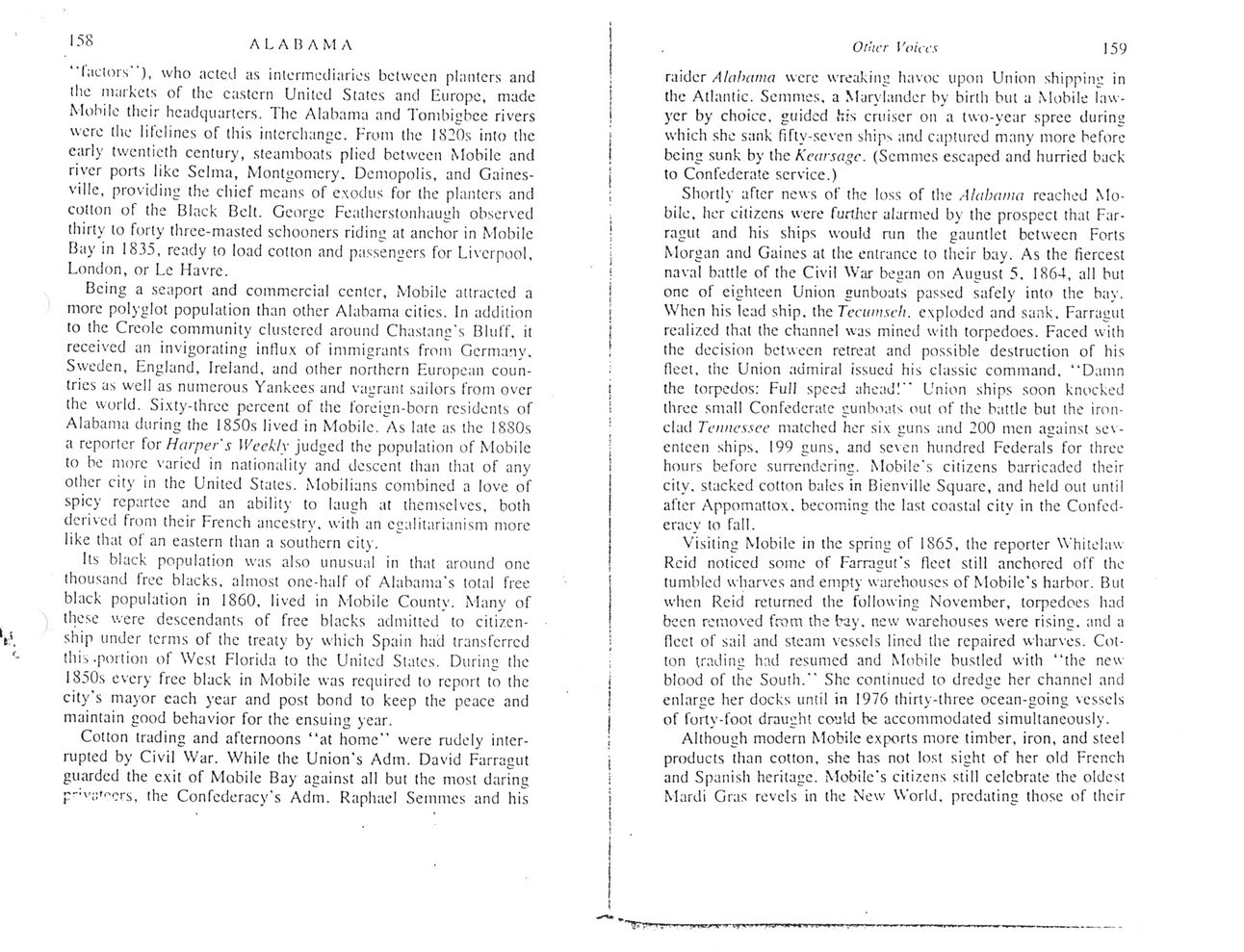This text was obtained via automated optical character recognition.
It has not been edited and may therefore contain several errors.
158 A L A B A M A ?factors"), who acted as intermediaries between planters and the markets of the eastern United States and Europe, made Mobile their headquarters. The Alabama and Tombigbee rivers were the litelines of this interchange. From the 1820s into the early twentieth century, steamboats plied between Mobile and river ports like Selma, Montgomery. Demopolis, and Gainesville, providing the chief means of exodus for the planters and cotton of the Black Belt. George Featherstonhaugh observed thirty lo forty three-masted schooners riding at anchor in Mobile Bay in 1835, ready to load cotton and passengers for Liverpool, London, or Le Havre. Being a seaport and commercial center. Mobile attracted a more polyglot population than other Alabama cities. In addition to the Creole community clustered around Chastang's Bluff, it received an invigorating influx of immigrants from Germany, Sweden, England, Ireland, and other northern European countries as well as numerous Yankees and vagrant sailors from over the world. Sixty-three percent of the foreign-born residents of Alabama during the 1850s lived in Mobile. As late as the 1880s a reporter for Harper's Weekly judged the population of Mobile to be more varied in nationality and descent than that of any other city in the United States. Mobilians combined a love of spicy repartee and an ability to laugh at themselves, both derived from their French ancestry, with an egalitarianism more like that of an eastern than a southern city. Its black population was also unusual in that around one thousand free blacks, almost onc-half of Alabama's total free black population in 1860, lived in Mobile County. Many of ^ these were descendants of free blacks admitted to citizen- kt4. ship under terms of the treaty by which Spain had transferred r? this .portion of West Florida to the United States. During the 1850s every free black in Mobile was required to report to the city?s mayor each year and post bond to keep the peace and maintain good behavior for the ensuing year. Cotton trading and afternoons ?at home? were rudely interrupted by Civil War. While the Union?s Adin. David Farragut guarded the exit of Mobile Bay against all but the most daring p-;v;;tr'ors, the Confederacy?s Adm. Raphael Semmes and his Other i'oiccs 159 raider Alabama were wreaking havoc upon Union shipping in the Atlantic. Semmes. a Marylander by birth but a Mobile lawyer by choice, guided his cruiser on a two-year spree during which she sank fifty-seven ships and captured many more before being sunk by the Kearsage. (Semmes escaped and hurried back to Confederate service.) Shortly after news of the loss of the Alabama reached Mobile, her citizens were further alarmed by the prospect that Farragut and his ships would run the gauntlet between Forts Morgan and Gaines at the entrance to their bay. As the fiercest naval battle of the Civil War began on August 5. 1864, all but one of eighteen Union gunboats passed safely into the bay. When his lead ship, the Tecmnseh. exploded and sank, Farragut realized that the channel was mined with torpedoes. Faced with the decision between retreat and possible destruction of his fleet, the Union admiral issued his classic command, ?Damn the torpedos: Full speed ahead!? Union ships soon knocked three small Confederate gunboats out of the battle but the ironclad Tennessee matched her six guns and 200 men against seventeen ships. 199 guns, and seven hundred Fcderals for three hours before surrendering. Mobile?s citizens barricaded their city, stacked cotton bales in Bienville Square, and held out until after Appomattox, becoming the last coastal city in the Confederacy to fall. Visiting Mobile in the spring of 1865, the reporter Whitelaw Reid noticed some of Farragut?s fleet still anchored off the tumbled wharves and empty warehouses of Mobile?s harbor. But when Reid returned the following November, torpedoes had been removed from the bay. new w-arehouses were rising, and a fleet of sail and steam vessels lined the repaired wharves. Cotton trading had resumed and Mobile bustled with ?the new blood of the South.? She continued to dredge her channel and enlarge her docks until in 1976 thirty-three ocean-going vessels of forty-foot draught could be accommodated simultaneously. Although modern Mobile exports more timber, iron, and steel products than cotton, she has not lost sight of her old French and Spanish heritage. Mobile's citizens still celebrate the oldest Mardi Gras revels in the New World, predating those of their

Alabama History-Book-Excerpt-04